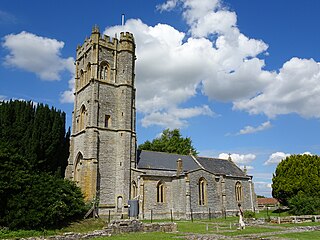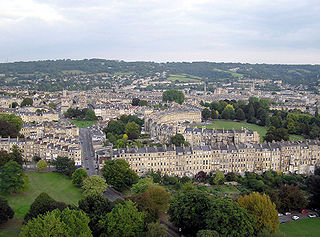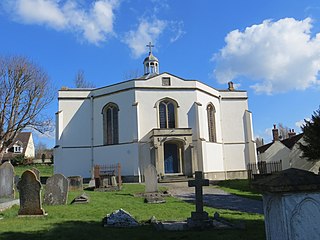
Frederick William Herschel was a German-born British astronomer and composer. He frequently collaborated with his younger sister and fellow astronomer Caroline Herschel. Born in the Electorate of Hanover, William Herschel followed his father into the military band of Hanover, before emigrating to Great Britain in 1757 at the age of nineteen.

Bath is a city and unparished area in the Bath and North East Somerset unitary area in the ceremonial county of Somerset, England, known for and named after its Roman-built baths. At the 2021 Census, the population was 101,557. Bath is in the valley of the River Avon, 97 miles (156 km) west of London and 11 miles (18 km) southeast of Bristol. The city became a World Heritage Site in 1987, and was later added to the transnational World Heritage Site known as the "Great Spa Towns of Europe" in 2021. Bath is also the largest city and settlement in Somerset.

The Abbey Church of Saint Peter and Saint Paul, commonly known as Bath Abbey, is a parish church of the Church of England and former Benedictine monastery in Bath, Somerset, England. Founded in the 7th century, it was reorganised in the 10th century and rebuilt in the 12th and 16th centuries; major restoration work was carried out by Sir George Gilbert Scott in the 1860s. It is one of the largest examples of Perpendicular Gothic architecture in the West Country. The medieval abbey church served as a sometime cathedral of a bishop. After long contention between churchmen in Bath and Wells the seat of the Diocese of Bath and Wells was later consolidated at Wells Cathedral. The Benedictine community was dissolved in 1539 during the Dissolution of the Monasteries.

The Bath Assembly Rooms, designed by John Wood the Younger in 1769, are a set of assembly rooms located in the heart of the World Heritage City of Bath in England which are now open to the public as a visitor attraction. They are designated as a Grade I listed building.

The Church of All Souls is a redundant Anglican church in Astley Street, Astley Bridge, Bolton, Lancashire, England. It is recorded in the National Heritage List for England as a designated Grade II* listed building, and is under the care of the Churches Conservation Trust. As of 2010, the church is being converted into a community centre.

John Snetzler was an organ builder of Swiss origin, who worked mostly in England. Born in Schaffhausen in 1710, he trained with the firm of Egedacher in Passau and came to London about 1741. When he retired in 1781, his business continued and ended up with Thomas Elliot. Snetzler died in Schaffhausen on 28 September 1785.

The Grade I listed buildings in Somerset, England, demonstrate the history and diversity of its architecture. The ceremonial county of Somerset consists of a non-metropolitan county, administered by Somerset County Council, which is divided into five districts, and two unitary authorities. The districts of Somerset are West Somerset, South Somerset, Taunton Deane, Mendip and Sedgemoor. The two administratively independent unitary authorities, which were established on 1 April 1996 following the breakup of the county of Avon, are North Somerset and Bath and North East Somerset. These unitary authorities include areas that were once part of Somerset before the creation of Avon in 1974.

St. Bridget's Church in Chelvey, Brockley, Somerset, England dates from the 12th century, and has been designated by English Heritage as a Grade I listed building.

The Church of St James in Winscombe, Somerset, England, has 12th- or 13th-century origins but the present building dates from the 15th century. It is a Grade I listed building.

The Church of St Andrew & St Mary in Pitminster, Somerset, England was built around 1300 and has been designated as a Grade I listed building.

The ParishChurch of St Mary, more commonly known as St Mary's, is the main Church of England parish church for the town of Bridgwater, Somerset. Originally founded well before the Norman Conquest, the present church is a large and imposing structure dating primarily from the 14th and 15th centuries, with both earlier remains and later additions.

The Church of St Peter and St Paul in Muchelney, Somerset, England, has Saxon origins, however the current building largely dates from the 15th century. It has been designated as a Grade I listed building.
Mallett Antiques is an "antiques" dealer with galleries in London and New York who regularly exhibit at the International Fine Art & Antique Fairs.

Milsom Street in Bath, Somerset, England was built in 1762 by Thomas Lightholder. The buildings were originally grand town houses, but most are now used as shops, offices and banks. Most have three storeys with mansard roofs and Corinthian columns.

Trim Street in Bath, Somerset, England is an historic street, built in 1707, of shops and houses, many of which are listed buildings. It was named after George Trim who owned the land.

The buildings and architecture of Bath, a city in Somerset in the south west of England, reveal significant examples of the architecture of England, from the Roman Baths, to the present day. The city became a World Heritage Site in 1987, largely because of its architectural history and the way in which the city landscape draws together public and private buildings and spaces. The many examples of Palladian architecture are purposefully integrated with the urban spaces to provide "picturesque aestheticism". In 2021, the city was added to a second World Heritage Site, a group of historic spa towns across Europe known as the "Great Spas of Europe". Bath is the only entire city in Britain to achieve World Heritage status, and is a popular tourist destination.

The following is a timeline of the history of the city of Bath, Somerset, England.

The Anglican Church of St Francis in Stawell, Somerset, England was built in the 13th century. It is a Grade II* listed building.

Christ Church is a Church of England church in Theale, Somerset, England. It was built in 1826–28 to the design of Richard Carver and is a Grade II listed building.

Holy Trinity Church is a Church of England church in Blackford, Somerset, England. It was built in 1821–23 to the designs of Richard Carver and has been a Grade II listed building since 1961.




















